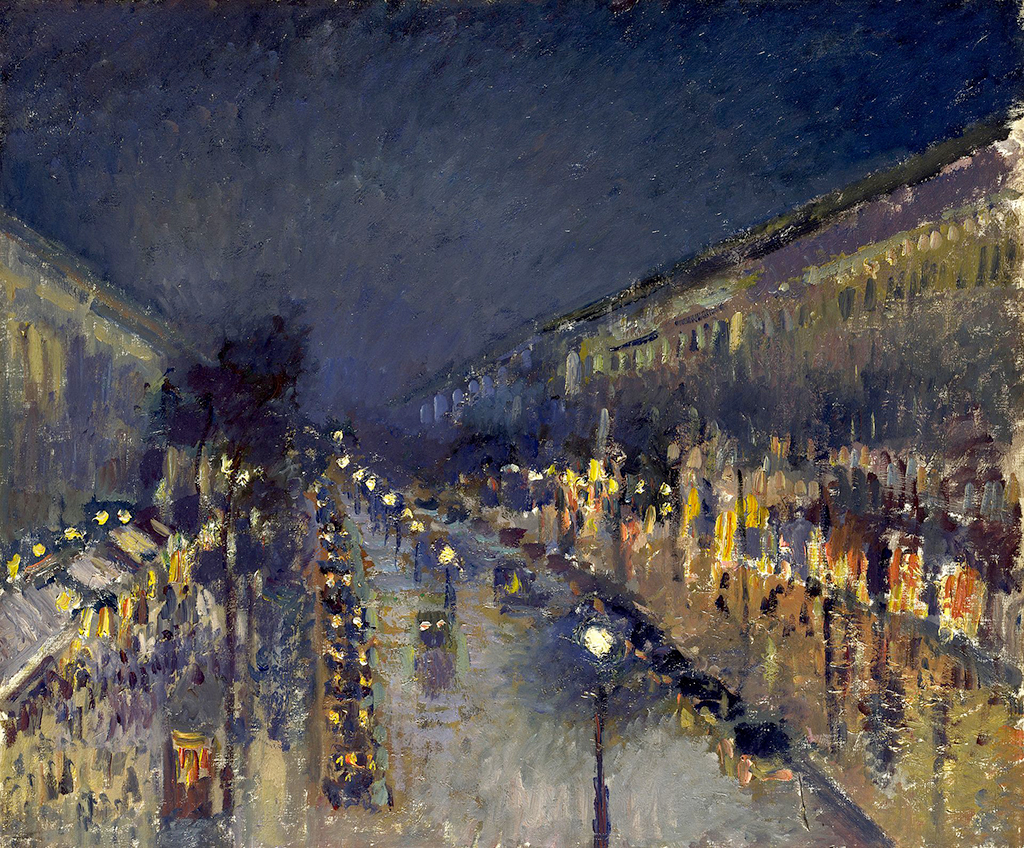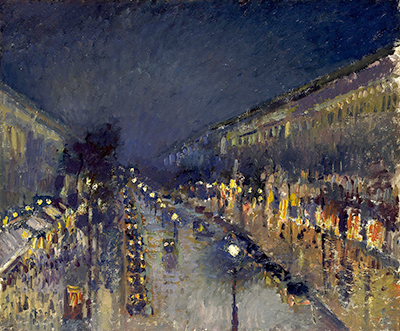In February 1897, Pissarro took to a room at the Hôtel de Russie located in Paris on the corner of one of the 4 'grands boulevards' called the Boulevard des Italiens plus the Rue Drouot, then created a series the Boulevard Montmartre paintings at different times.
Introduction
The architecture of Paris has been much loved for centuries, and artists have flocked to the city to produce scenes of it within their own work. Pissarro understood its possibilities as he hired a room specifically for this purpose, and he would spend many hours studying the intricate details of the city from various angles. It would inspire a number of artworks, with The Boulevard Montmartre at Night being amongst the most famous. This body of work would become known as a major highlight within his career and it would also encourage others to devote more time to the cityscape genre. Additionally, as the reputation of the Impressionists spread, it would also bring the beauty of Paris architecture to new audiences overseas, even though most were entirely aware of its qualities. There was a melting pot of artists in Paris at the time, innovating new ideas which would spread internationally over the next few generations and paintings such as the one displayed here help to capture the mood and energy of Paris at that time.
The series that he produced of the boulevard in Paris would be amongst his last, with the artist passing away around six years after these pieces were completed. We can therefore see Pissarro at the height of his powers, having evolved to his fullest and comfortable in the style and content that he was now focusing on. Perhaps his elderly age influenced the artist's decision to focus on life in Paris, as he became curious about modern life at a time when his own was starting to draw to a close. Perhaps he was amazed by how busy city life had become, just as American painter Childe Hassam had done too. The Impressionist movement itself had already been around for several decades and most of its key exponents were also fairly old by now, opening the way for new movements to come through. Clearly, this was a time of change in many ways and Pissarro felt happy to view this transition from the comfort of a hotel window. The whole idea of painting from a window has appeared many times within art history, and in some examples the artist might include the room in which they sit as part of the composition.
The artwork sits within the permanent collection of the National Gallery in London, who themselves own around a dozen paintings from his career. This selection covers a good range of the different genres in which Pissarro was involved, including portraits and a good number of landscape scenes based around rural France. This style and content proves highly popular today internationally, though his series of the boulevards of Paris remains a key element to his success. French galleries continue to serve his career particularly well and his prominent role within the Impressionist movement ensures that his reputation will never be forgotten. Even those unaware of his career will appreciate these very accessible artworks which will remind many of a holiday taken in Paris, or just a general love of historical architecture. Please see below for detailed information about Camille Pissarro's The Boulevard Montmartre at Night, touching on the style, meaning, artistic techniques and history behind this delightful artwork.
Table of Contents
- Description
- The Boulevard Montmartre Series
- Techniques
- Location, Size and Medium
- Influence
- History of the Boulevard Montmartre
- Large Image
Description
Boulevard Montmartre at Night displays the busy Parisian boulevard, but at night right after a downpour. The work gave the Danish-French artist the opportunity of studying the new electric street lamps' effect as they are aligned at the street as well as the orange glow of those gas lights seen in the windows. He tried to represent the various effects that artificial lights have in different colours: bluish and pale as well as intense. Abstract vertical shapes in the painting represent the crowds moving under the trees and beyond the shops. On one side of this road, there is a series of carriages that are lined and the lights are on, waiting for the exit of the guests who were at the show that took place at the Moulin Rouge, which is located just around the corner. The sky is dark and misty, and the clouds are seen hanging in the air. But stars that are seen in the sky (the small sketches of white), show that the clouds are going to pass soon. He would likely have added these small touches of pure paint right at the end, placing them over all the previous layers of oils.
The Boulevard Montmartre Series
The artist produced a series of the same scene and view, but in different climatic conditions, at different hours of the day. Pissarro painted this perspective while he was at his window and this led to a series of paintings from the top of the road Boulevard Montmartre. The artist was very impressed because he could see down the entire length of this road and he also had a bird’s-eye view of omnibuses, carriages and people between big trees and huge houses that had to be set straight. The way in which the main elements of the scene converge towards a point towards the back of the painting provides a balance to the composition and may have also made it easier for Pissarro to lay out the initial design - he is likely to have made some preparatory drawings first in pencil or charcoal in order to get the angles just as he saw them in real life. These may not have been overly detailed, and just within a small sketchbook. After producing several paintings already in the series, he would have then started to work more from habit and memory, as this stunning view etched itself permanently in the back of his mind.
Techniques
As with the entire fourteen series of paintings, the strong central shape of this receding boulevard, which is flanked by impressive buildings and rows of trees, dictates the simple and powerful composition plus perspective, given intensity by the high viewpoint. Pissarro used strong brushstrokes on the roads and sky to draw the viewer's eye down the busy street. Sketchily painted carriages and figures, like blurred photographs, add a bustling movement. However, the effect of the pearly winter sun spread through mist has made this view calmer when compared to the others. The artist used a broad pointillism in most places like on the road surface. Individual dabs, strokes and dots of paint can be seen for those who stand close to the artwork in its current location at the National Gallery in London. Because of the painting's relatively small size, one does not have to stand too far back before all of these subtle touches merge together to create Pissarro's 'impression' of the boulevard, just as the artist would have intended. Larger canvases were rare in this movement, though Monet did experiment with some huge canvases for a small number of projects.
Location, Size and Medium
The Boulevard Montmartre at Night can today be found at the National Gallery in London, UK. Generally speaking, it is out on permanent display and is normally to be found within Room 43. The venue itself hosts a fine selection of impressionist art, with the rest of the collection focusing on movements prior to the 19th century. This is therefore one of the more modern artworks to be found here. This popular destination is based in Trafalgar Square in the centre of the city, and a number of other notable art galleries can be found close by. Between them, they offer a great variety of artistic styles, dating back to the early years of the kingdom, all the way up to the present day. The gallery lists The Boulevard Montmartre at Night as being 64.8cm in width, by 53.3cm in height and it was producing using oils on canvas, which was entirely typical of Pissarro's oeuvre. The Impressionists would not often use canvases much larger than this, and the format was also highly suitable for exhibiting their work around Parisien art galleries, normally immediately after being completed.
Influence
The artist was probably influenced by Monet's series of paintings that he was was producing during that period and the earlier Manet Urban scenes. From this series that Pissarro produced, the Boulevard Montmartre is the only night scene, and it's a masterful interpretation of the amazing play of lights on wet, dark streets. During his lifetime, Pissarro did not display or sign it. See also the contributions from Caillebotte's paintings. Cityscapes were a key element of Impressionist art, even though most today are more aware of the landscape scenes from Monet. Paris was an exciting, vibrant city during the 19th century and became the art centre of the world, with painters such as Pissarro hoping to capture some of its energy and architectural beauty within their work. The study of weather and climate within art was also an important aspect of the Impressionist movement, and several members would capture the same content at different times of the day, or in different seasons in order to better understand how the changing conditions would impact the objects of the scene in different ways.
History of the Boulevard Montmartre
Paris is memorable for the series of boulevards which stretch across the city and these were constructed at different points over the last few centuries. They are collectively known as the Grands Boulevards and the specific Boulevard Montmartre was itself constructed in 1763. Pissarro's painting perfectly captures the length and consistency of the architecture, as it runs off into the distance. The presence of the row of cars allows us to get a sense of size and perspective. The ground floor to the left and right are filled with shops and cafes, as local Parisiens celebrate love and life as only they know how. The same structure remains there now, all these years later, ensuring that very little would have changed if you superimposed this painting over the same location today. The same can be said for other cityscapes of Paris from the 19th century, with strong efforts made to protect the best of the city's architecture, whilst also allowing new innovations elsewhere.
Large Image
Camille Pissarro paid considerable attention to the features of the boulevard within this artwork, just as with the rest of the series, and so we have included a larger image of the painting below. The movement produced art which was best viewed from a slight distance, where all of the flourishes and expressive elements would fuse together into a single image. Up close, one might not recognise elements because of how Impressionist artists worked, as compared to the Realism movement, for example. They would essentially create an 'impression' which worked best from a reasonable distance. The same can also be said for artists that they were influenced by, such as Turner, where individual brushstrokes would not really work by themselves, for those staring too closely at a painting, with their faces up against the canvas. The larger image below was provided by Wikipedia, also also have some interesting content on the history of this artwork as well as the artist who created it.





